Mechanical Properties and Thermal Shock Behavior of Al2O3-YSZ Ceramic Layers Obtained by Atmospheric Plasma Spraying
Abstract
:1. Introduction
2. Materials and Methods and Thermal Shock Experimental Set-Up
3. Experimental Results
3.1. Thermal Shock Behavior of the Experimental Samples
3.2. X-ray Diffraction Analyze of the Ceramic Layer
3.3. XRD—Residual Stress Mapping
3.4. Mechanical Characterization of Ceramic Layer at Scratch Test
4. Conclusions
- Solar energy can be used to heat different materials with repetitive high rates, exposure time and controlled parameters to simulate a possible thermal shock.
- The composition of the complex coatings remained the same regardless of the number of thermal shock cycles, being a mixture of crystalline yttrium zirconium oxide and α and γ alumina. In all cases, the main residual stress state for all samples was tensile. After five thermal shock cycles, a uniformity of the residual stress state was observed on the investigated surface. Ten thermal shock cycles led to higher residual stresses and resulted in large cracks and the spallation of the coating.
- Even though increasing the temperature to a very high temperature (above 1800 °C) will cause the exfoliation of the ceramic layer, heating to 1000 °C at a high rate and cooling at the same conditions does not change the microstructure of the ceramic layer or the composition of the phases and retains mechanical and adhesion properties similar to the initial state. Al2O3-YSZ ceramic layers with a thickness of approximately 45 μm are stable to thermal shocks at 1000 °C and under atmospheric conditions.
Author Contributions
Funding
Data Availability Statement
Acknowledgments
Conflicts of Interest
References
- Liu, Z.; Chu, Z.H.; Dong, Y.C.; Yang, Y.; Chen, X.G. The effect of metallic bonding layer on the corrosion behavior of plasma sprayed Al2O3 ceramic coatings in simulated sea water. Vacuum 2014, 101, 6–9. [Google Scholar] [CrossRef]
- Bernevig-Sava, M.A.; Stamate, C.; Lohan, N.M.; Baciu, A.M.; Postolache, I.; Baciu, C.; Baciu, E.R. Considerations on the surface roughness of SLM processed metal parts and the effects of subsequent sandblasting. In IOP Conference Series: Materials Science and Engineering; IOP Publishing: Bristol, UK, 2019. [Google Scholar]
- Wang, Y.; Jiang, S.; Wang, M.; Wang, S.; Xiao, D.T.; Strutt, P.R. Abrasive wear characteristics of plasma sprayed nanostructured alumina/titania coatings. Wear 2000, 237, 176–185. [Google Scholar] [CrossRef]
- Yan, D.; He, J.; Wu, J.; Qiu, W.; Ma, J. The corrosion behavior of plasma spraying Al2O3 ceramic coating in dilute HCl solution. Surf. Coat. Technol. 1997, 89, 191–195. [Google Scholar]
- Singh, V.P.; Sil, A.; Jayaganthan, R. A study of sliding and erosive wear behavior of atmospheric plasma sprayed conventional and nanostructured alumina coatings. Mater. Des. 2011, 32, 584–591. [Google Scholar] [CrossRef]
- Ramachandran, K.; Selvarajan, V.; Ananthapadmanabhan, P.V.; Sreekumar, K.P. Microstructure, adhesion, microhardness, abrasive wear resista-ce and electrical resistivity of the plasma sprayed alumina and alumina-titania coatings. Thin Solid Film 1998, 315, 144–152. [Google Scholar] [CrossRef]
- Mindivan, H.; Tekmen, C.; Dikici, B.; Tsunekawa, Y.; Gargali, M. Wear behavior of plasma sprayed composite coatings with in situ formed Al2O3. Mater. Des. 2009, 30, 4516–4520. [Google Scholar] [CrossRef]
- Afrasiabi, A.; Saremi, M.; Kobayashi, A. A comparative study on hot corrosion resistance of three types of thermal barrier coatings: YSZ, YSZ+Al2O3 and YSZ/Al2O3. Mat. Sci. Eng. A 2008, 478, 264–269. [Google Scholar] [CrossRef]
- Gao, J.; He, Y.; Wang, D. Fabrication and high temperature oxidation resistance of ZrO2/Al2O3 micro laminated coatings on stainless steel. Mater. Chem. Phys. 2010, 123, 731–736. [Google Scholar] [CrossRef]
- Chang, C.C.; Yen, S.K. Characterization of electrolytic ZrO2/Al2O3 double layer coating on AISI 440 C stainless steel. Surf. Coat. Technol. 2004, 182, 242–250. [Google Scholar] [CrossRef]
- Jakovljevic, S.; Hendrix, W.; Havermans, D.; Meneve, J. Characterization of ZrO2 layers deposited on Al2O3 coating. Wear 2009, 266, 417–423. [Google Scholar] [CrossRef]
- Sathish, S.; Geetha, M.; Aruna, S.T.; Balaji, N.; Rajam, K.S.; Asokamani, R. Sliding wear behavior of plasma sprayed nano ceramic coatings for biomedical applications. Wear 2011, 271, 934–941. [Google Scholar] [CrossRef]
- Sathish, S.; Geetha, M.; Aruna, S.T.; Balaji, N.; Rajam, K.S.; Asokamani, R. Studies on plasma sprayed bilayered ceramic coating on biomedical Ti–13Nb–13Zr alloy. Ceram. Int. 2011, 37, 1333–1339. [Google Scholar] [CrossRef]
- Maccauro, G.; Bianchino, G.; Sangiorgi, S.; Magnani, G.; Marotta, D.; Manicone, P.F.; Raffaelli, L.; Rossi Iommetti, P.; Stewart, A.; Cittadini, A.; et al. Development of a new zirconia-toughened alumina: Promising mechanical properties and absence of in vitro carcinogenicity. Int. J. Immunopathol. Pharmacol. 2009, 22, 773–779. [Google Scholar] [CrossRef] [PubMed]
- Yang, S.F.; Yang, L.Q.; Jin, Z.H.; Guo, T.W.; Wang, L.; Liu, H.C. New nano-sized Al2O3-BN coating 3Y-TZP ceramic composites for CAD/CAM-produced all-ceramic dental restorations. Part I. Fabrication of powders. Nanomed. Nanotechnol. Biol. Med. 2009, 5, 232–239. [Google Scholar] [CrossRef] [PubMed]
- Kim, D.J.; Lee, M.H.; Lee, D.Y.; Han, J.S. Mechanical properties, phase stability, and biocompatibility of (Y, Nb)- TZP/Al2O3 composite abutments for dental implant. J. Biomed. Mater. Res. 2000, 53, 438–443. [Google Scholar] [CrossRef]
- Affatato, S.; Testoni, M.; Cacciari, G.L.; Toni, A. Mixedoxides prosthetic ceramic ball heads. Part II: Effect of the ZrO2 fraction on the wear of ceramic on ceramic joints. J. Appl. Biomater. 1999, 20, 1925–1929. [Google Scholar] [CrossRef]
- De Aza, A.H.; Chevalier, J.; Fantozzi, G.; Schehl, M.; Torrecillas, R. Crack growth resistance of alumina, zirconia and zirconia toughened alumina ceramics for joint prostheses. J. Appl. Biomater. 2002, 23, 937–945. [Google Scholar] [CrossRef]
- Bejinariu, C.; Paleu, V.; Stamate, C.V.; Cimpoesu, R.; Coteata, M.; Badarau, G.; Axinte, M.; Istrate, B.; Vasilescu, G.D.; Cimpoesu, N. Microstructural, Corrosion Resistance, and Tribological Properties of Al2O3 Coatings Prepared by Atmospheric Plasma Spraying. Materials 2022, 15, 9013. [Google Scholar] [CrossRef]
- Kelly, J.R.; Denry, I. Stabilized zirconia as a structural ceramic: An overview. Dent. Mater. 2008, 24, 289–298. [Google Scholar] [CrossRef]
- Denry, I.; Kelly, J.R. State of the art of zirconia for dental applications. Dent. Mater. 2008, 24, 299–307. [Google Scholar] [CrossRef]
- Deville, S.; Chevalier, J.; Fantozzi, G.; Bartolomé, J.F.; Requena, J.; Moya, J.S.; Torrecillas, R.; Díaz, L.A. Low-temperature ageing of zirconia-toughened alumina ceramics and its implication in biomedical implants. J. Eur. Ceram. Soc. 2003, 23, 2975–2982. [Google Scholar] [CrossRef] [Green Version]
- Zhong, X.; Zhao, H.; Zhou, X.; Liu, C.; Wang, L.; Shao, F.; Yang, K.; Tao, S.; Ding, C. Thermal shock behavior of toughened gadolinium zirconate/YSZ double-ceramic-layered thermal barrier coating. J. Alloys Compd. 2014, 593, 50–55. [Google Scholar] [CrossRef]
- Vert Pierre, R.; Pierre, C.; Laborde, E.; Mariaux, G.; Meillot, E.; Vardelle, A.M. Adhesion of Ceramic Coating on Thin and Smooth Metal Substrate: A Novel Approach with a Nanostructured Ceramic Interlayer. J. Therm. Spray Technol. 2012, 21, 6. [Google Scholar]
- Luțcanu, M.; Coteață, M.; Bernevig, M.A.; Nechifor, C.D.; Cazacu, M.M.; Paraschiv, P.; Istrate, B.; Bădărău, G.; Sandu, I.G.; Cimpoeșu, N. Obtaining and analyzing the Al2O3-ZrO2 ceramic layers on metallic substrate. Arch. Metall. Mater. 2022, 67, 479–485. [Google Scholar]
- Bernevig-Sava, M.A.; Darabont, D.C.; Lohan, M.; Mihalache, E.; Bejinariu, C. Selection and verification of personal protective equipment in the context of current legal requirements. Qual.-Access Success 2019, 20, 109–112. [Google Scholar]
- Munteanu, C.; Paleu, V.; Istrate, B.; Dascalu, A.; Paleu, C.C.; Bhaumik, S.; Ancas, A.D. Tribological Behavior and Microstructural Analysis of Atmospheric Plasma Spray Deposited Thin Coatings on Cardan Cross Spindles. Materials 2021, 14, 7322. [Google Scholar] [CrossRef] [PubMed]
- Meunier, C.; Zuo, F.; Peillon, N.; Saunier, S.; Marinel, S.; Goeuriot, D. In situ study on microwave sintering of ZTA ceramic: Effect of ZrO2 content on densification, hardness, and toughness. J. Am. Ceram. Soc. 2017, 100, 929–936. [Google Scholar] [CrossRef]
- Dejang, N.; Limpichaipanit, A.; Watcharapasorn, A.; Wirojanupatump, S.; Niranatlumpong, P.; Jiansirisomboon, S. Fabrication and Properties of Plasma-Sprayed Al2O3/ZrO2 Composite Coatings. J. Therm. Spray Technol. 2011, 20, 1259–1268. [Google Scholar] [CrossRef]
- Chen, D.; Jordan, E.; Gell, M. Microstructure of Suspension Plasma Spray and Air Plasma Spray Al2O3-ZrO2 Composite Coatings. J. Therm. Spray Technol. 2009, 18, 421–426. [Google Scholar] [CrossRef]
- Owoseni, T.; Bai, M.; Hussain, T.; Faisal, N.H.; Lee, T.L.; Kelleher, L. Neutron diffraction residual stress measurements in suspension HVOF sprayed Al2O3 and YSZ coatings. In Proceedings of the Conference: International Thermal Spray Conference, Orlando, FL, USA, 7–10 May 2018; pp. 490–495. [Google Scholar]
- Santos, P.S.; Santos, H.S.; Toledo, S.P. Standard transition aluminas. Electron microscopy studies. Mat. Res. 2000, 3, 104–114. [Google Scholar] [CrossRef] [Green Version]
- Derkach, E.A.; Buyakova, S.P.; Kulkov, S. Effects of transient thermal shock loadings on the structure of zirconia ceramics. In IOP Conference Series Materials Science and Engineering; IOP Publishing: Bristol, UK, 2016; Volume 156, p. 012029. [Google Scholar]
- Zhao, M.L.; Luo, L.M.; Lin, J.S.; Zan, X.; Zhu, X.Y.; Luo, G.N.; Wu, Y.C. Thermal shock behavior of W-0.5 wt% Y2O3 alloy prepared via a novel chemical method. J. Nucl. Mater. 2016, 479, 616–622. [Google Scholar] [CrossRef]
- Dollase, W.A. Correction of intensities for preferred orientation in powder diffractometry: Application of the March model. J. Appl. Cryst. 1986, 19, 267–272. [Google Scholar] [CrossRef]
- Pina, J.; Dias, A.; Lebrun, J.L. Study by X-ray diffraction and mechanical analysis of the residual stress generation during thermal spraying. Mater. Sci. Eng. A 2003, 347, 21–31. [Google Scholar] [CrossRef] [Green Version]
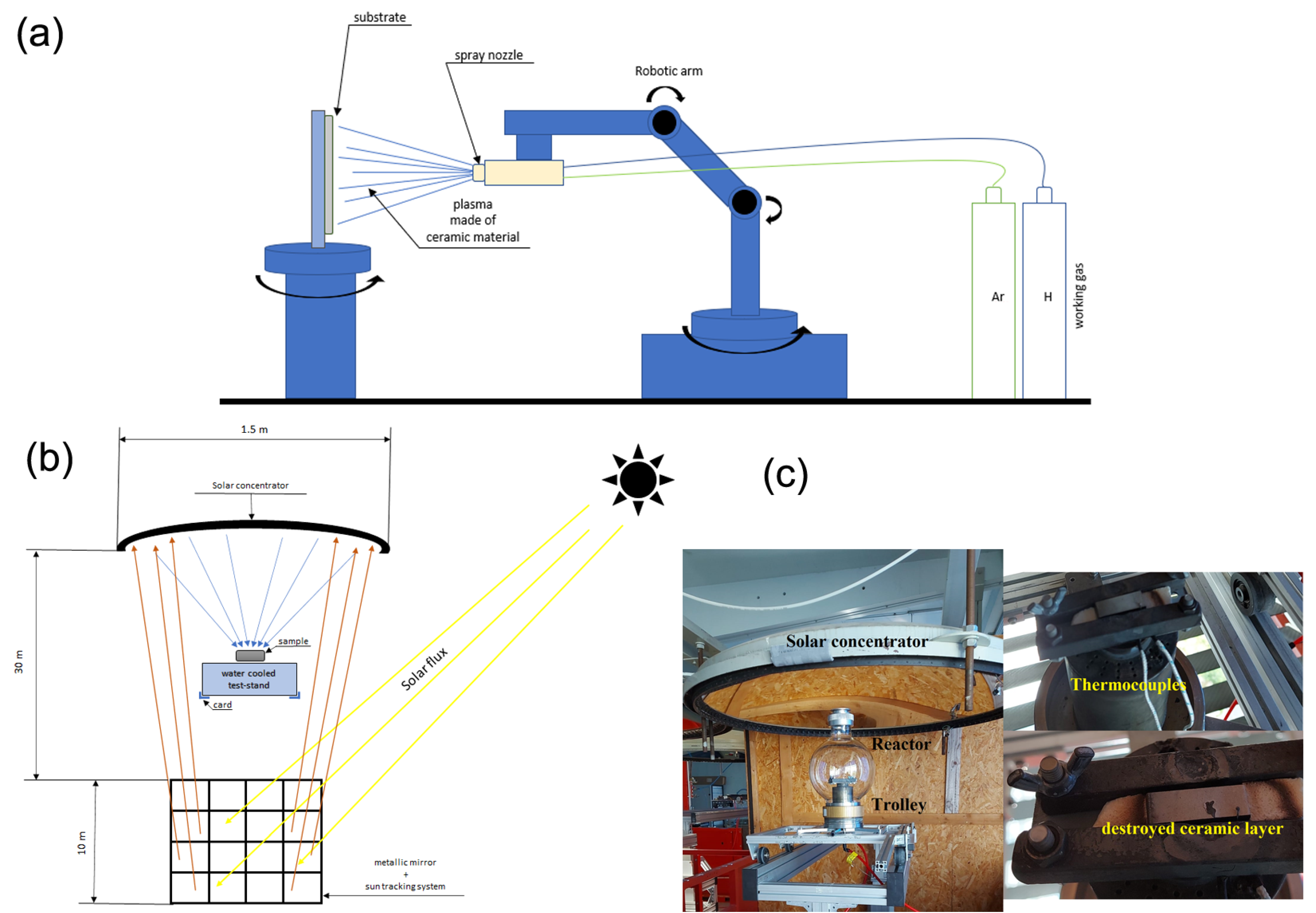
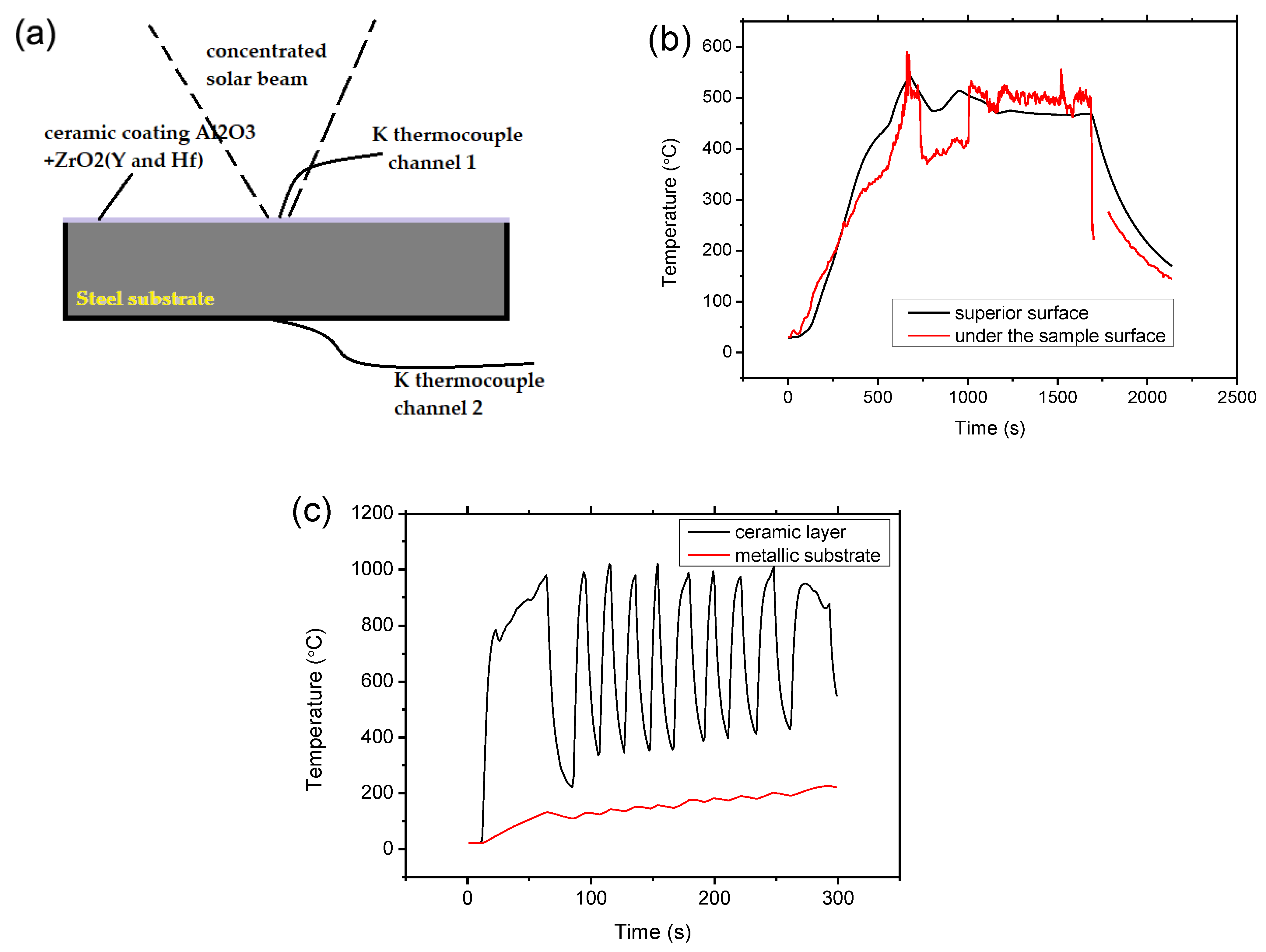

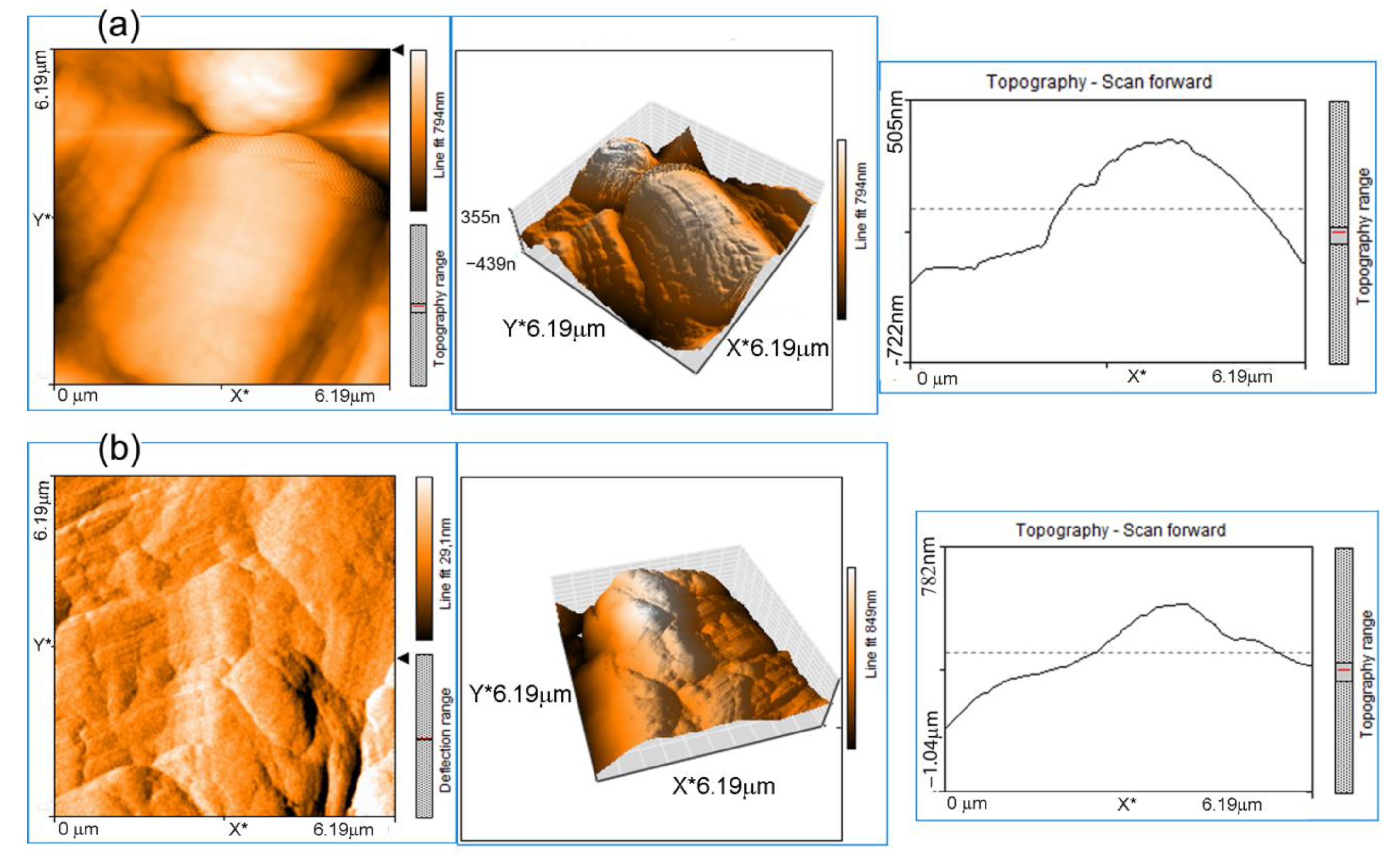
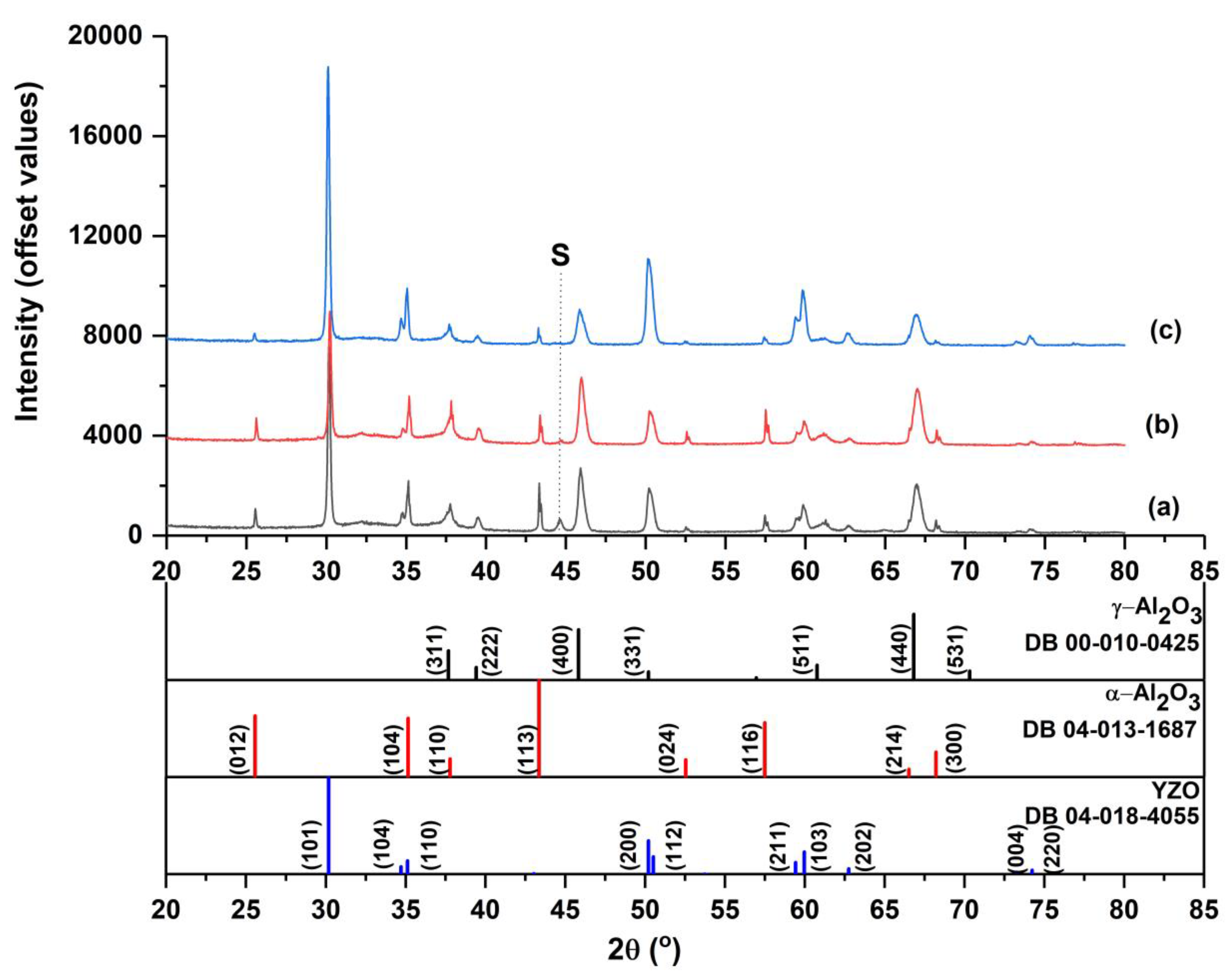
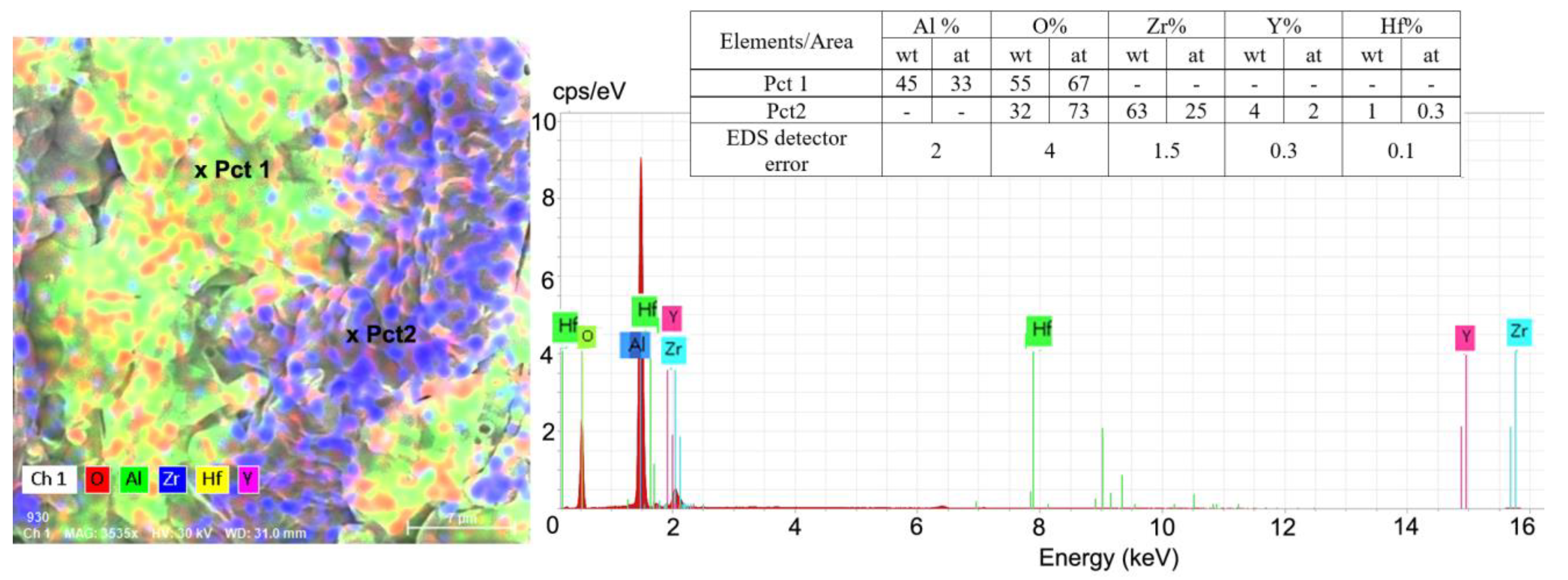
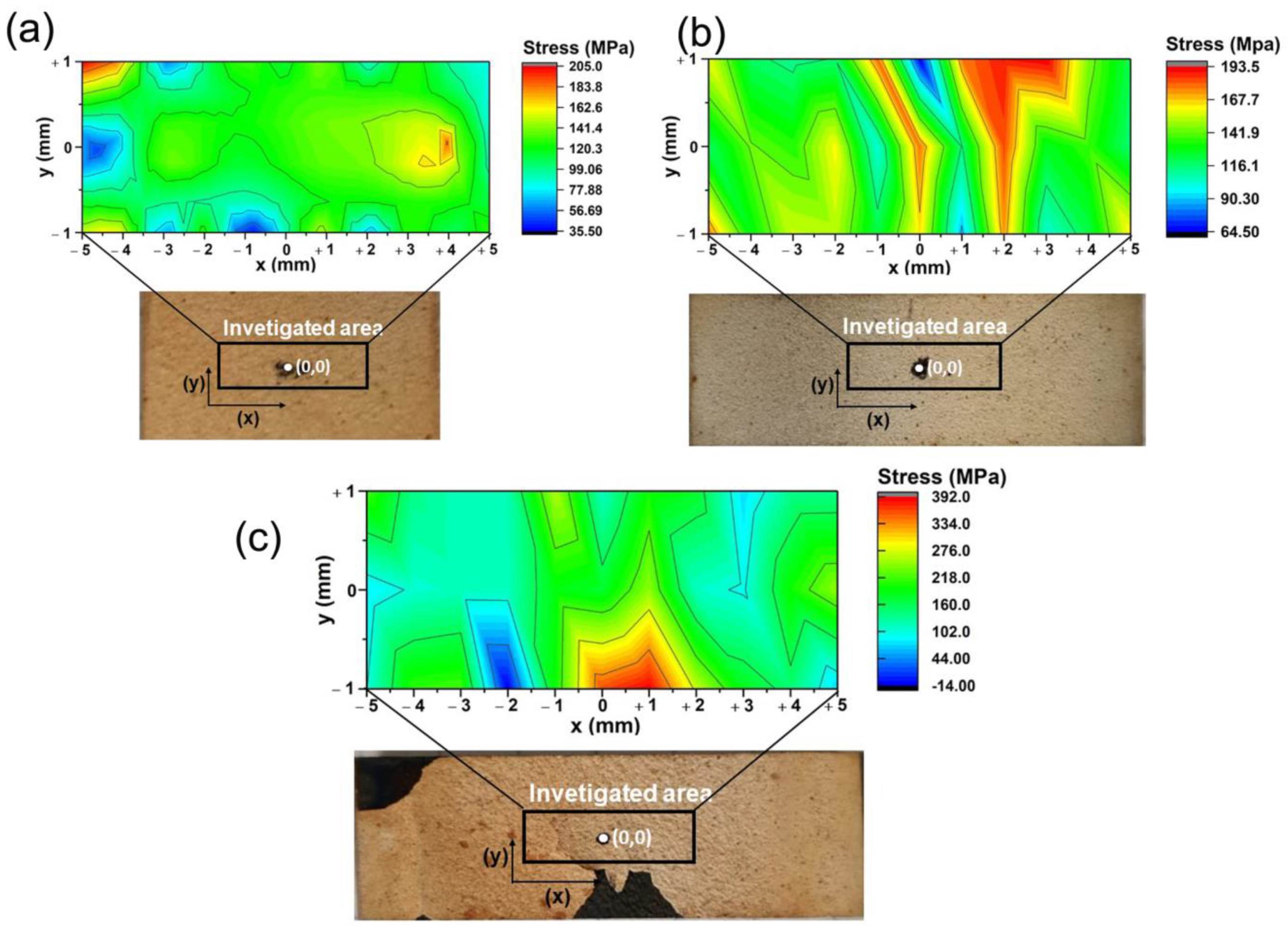
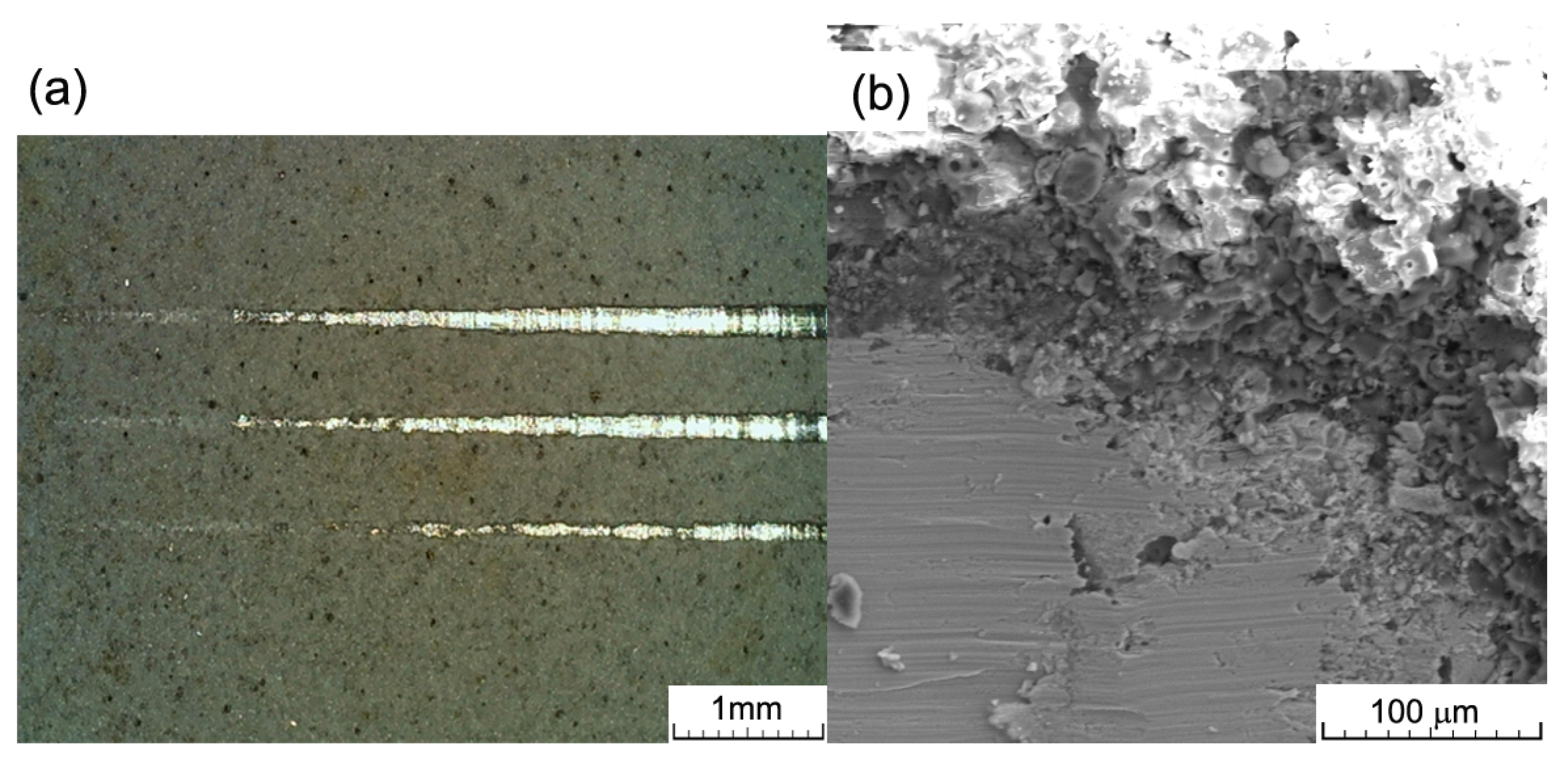

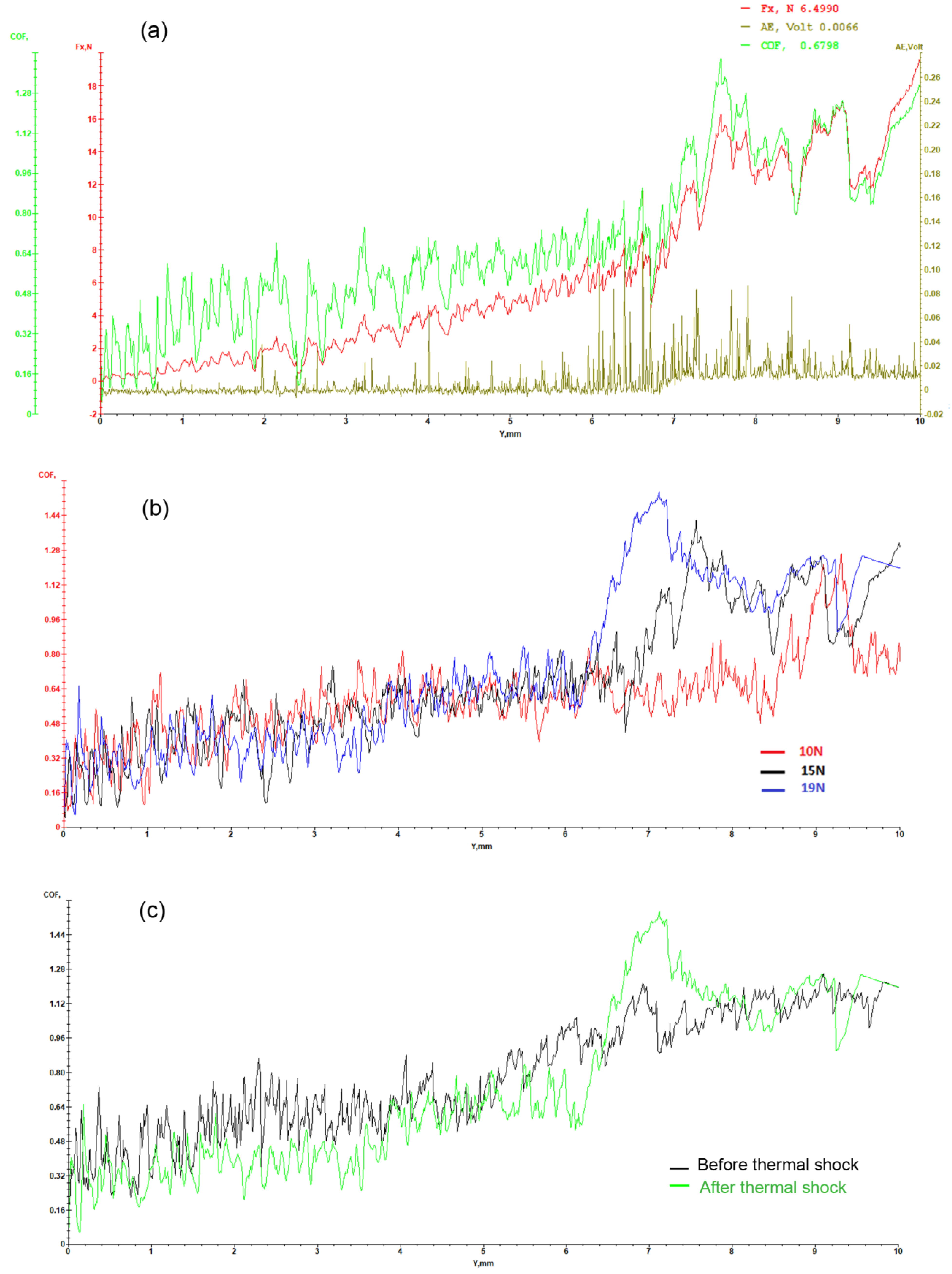
| Sample | YZO | α-Al2O3 | γ-Al2O3 | |||
|---|---|---|---|---|---|---|
| DB Card, PDF4+ | wt% | DB Card, PDF4+ | wt% | DB Card, PDF4+ | wt% | |
| PS | 04-018-4055 | 12.67 ± 0.12 | 04-013-1687 | 9.10 ± 0.30 | 00-010-0425 | 77.40 ± 1.40 |
| 5c | 04-018-4055 | 13.24 ± 1.66 | 04-013-1687 | 10.80 ± 0.40 | 00-010-0425 | 75.90 ± 1.80 |
| 10c | 04-018-4055 | 12.36 ± 1.50 | 04-013-1687 | 11.30 ± 0.60 | 00-010-0425 | 74.28 ± 1.90 |
| Sample | YZO | α-Al2O3 | γ-Al2O3 | |||
|---|---|---|---|---|---|---|
| Lattice Parameter (Å) | Crystallite Size (nm) | Lattice Parameter (Å) | Crystallite Size (nm) | Lattice Parameter (Å) | Crystallite Size (nm) | |
| PS | a = 3.616 | 91.2 ± 0.7 | a = 4.758 | 68.3 ± 3.9 | a = 7.900 | 17.6 ± 0.1 |
| c = 5.161 | c = 12.990 | |||||
| 5c | a = 3.616 | 75.5 ± 3.0 | a = 4.760 | 86.6 ± 0.9 | a = 7.901 | 25.3 ± 0.6 |
| c = 5.162 | c = 12.991 | |||||
| 10c | a = 3.615 | 56.6 ± 2.2 | a = 4.759 | 73.8 ± 0.9 | a = 7.902 | 13.4 ± 0.2 |
| c = 5.162 | c = 12.996 | |||||
| PDF Card | 00-010-0425, γ-Al2O3 |
|---|---|
| [hkl] | 440 |
| 2θ range (°) | 104–116 |
| Step size (°) | 0.1° |
| Scan duration (s) | 200 |
| Tilt angle range (°)/number of points | 0–30/8 |
| 2θ without strain (°) | 110.306 |
| Scanning direction | x |
| X range/scan step (mm) | [−5:+5]/1 |
| Y range/scan step (mm) | [−1:+1]/1 |
| Material | Fx [N] | AE [Volt] | COF | |||
|---|---|---|---|---|---|---|
| Before | After | Before | After | Before | After | |
| Ceramic coating + metallic substrate (10N) | 3.52 | 3.58 | −0.001 | 0.003 | 0.61 | 0.59 |
| Ceramic coating + metallic substrate (15N) | 6.62 | 6.49 | −0.001 | 0.007 | 0.73 | 0.68 |
| Ceramic coating + metallic substrate (19N) | 9.20 | 9.05 | 0.001 | 0.007 | 0.79 | 0.74 |
Disclaimer/Publisher’s Note: The statements, opinions and data contained in all publications are solely those of the individual author(s) and contributor(s) and not of MDPI and/or the editor(s). MDPI and/or the editor(s) disclaim responsibility for any injury to people or property resulting from any ideas, methods, instructions or products referred to in the content. |
© 2023 by the authors. Licensee MDPI, Basel, Switzerland. This article is an open access article distributed under the terms and conditions of the Creative Commons Attribution (CC BY) license (https://creativecommons.org/licenses/by/4.0/).
Share and Cite
Luțcanu, M.; Cimpoeșu, R.; Abrudeanu, M.; Munteanu, C.; Moga, S.G.; Coteata, M.; Zegan, G.; Benchea, M.; Cimpoeșu, N.; Murariu, A.M. Mechanical Properties and Thermal Shock Behavior of Al2O3-YSZ Ceramic Layers Obtained by Atmospheric Plasma Spraying. Crystals 2023, 13, 614. https://doi.org/10.3390/cryst13040614
Luțcanu M, Cimpoeșu R, Abrudeanu M, Munteanu C, Moga SG, Coteata M, Zegan G, Benchea M, Cimpoeșu N, Murariu AM. Mechanical Properties and Thermal Shock Behavior of Al2O3-YSZ Ceramic Layers Obtained by Atmospheric Plasma Spraying. Crystals. 2023; 13(4):614. https://doi.org/10.3390/cryst13040614
Chicago/Turabian StyleLuțcanu, Marian, Ramona Cimpoeșu, Mărioara Abrudeanu, Corneliu Munteanu, Sorin Georgian Moga, Margareta Coteata, Georgeta Zegan, Marcelin Benchea, Nicanor Cimpoeșu, and Alice Mirela Murariu. 2023. "Mechanical Properties and Thermal Shock Behavior of Al2O3-YSZ Ceramic Layers Obtained by Atmospheric Plasma Spraying" Crystals 13, no. 4: 614. https://doi.org/10.3390/cryst13040614








